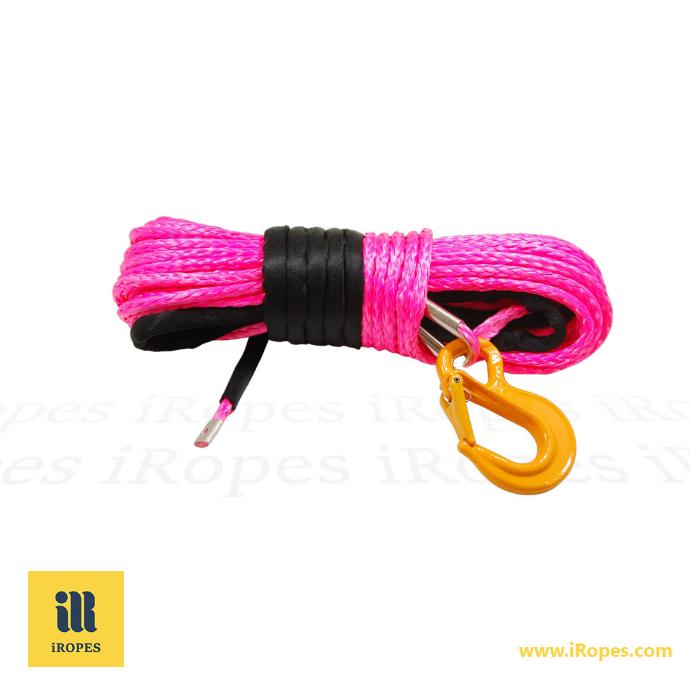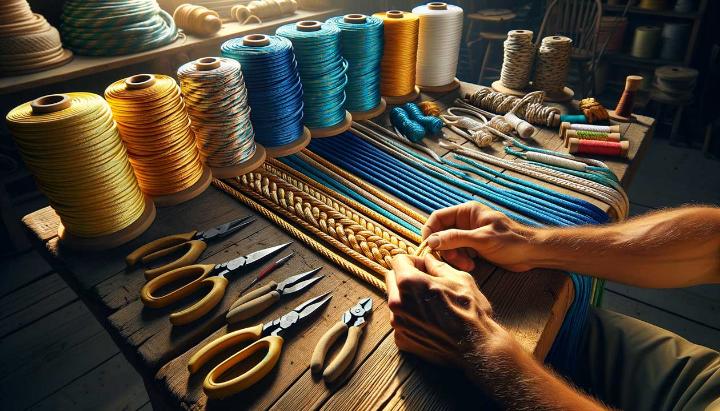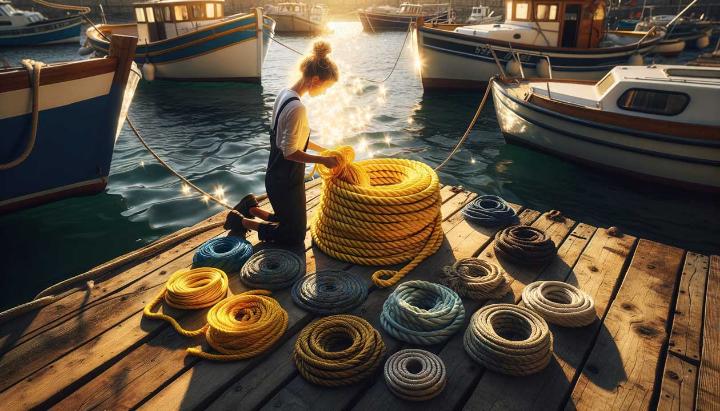Did you know that the right rope material can mean the difference between success and failure in critical situations? From scaling towering cliffs to securing massive cargo ships, the world of rope making is a fascinating blend of science and art. At iRopes, we've spent years perfecting the craft of creating high-performance ropes for diverse industries, and we're excited to take you on a journey through the intricate world of rope materials and braiding techniques.
In this comprehensive guide, we'll unravel the mysteries of UHMWPE, Nylon, Polyester, Kevlar, Technora, and Vectran - the powerhouse materials that form the backbone of modern rope making. We'll explore their unique properties, compare their strengths and weaknesses, and reveal how different braiding techniques can enhance their performance.
Whether you're a seasoned professional in need of custom rope solutions or an enthusiast curious about the science behind rope making, this post will equip you with the knowledge to make informed decisions about rope materials. Join us as we delve into the fibres that bind our world together and discover how mastering rope making can elevate your projects to new heights.
Understanding Different Rope Materials
When it comes to rope making, choosing the right material is crucial for ensuring optimal performance and durability. As an experienced rope maker, I've had the pleasure of working with a wide variety of materials, each with its own unique properties and advantages. Let's dive into the fascinating world of rope materials and explore how they can impact your next project.
Natural vs Synthetic Rope Fibers
Rope materials can be broadly categorized into two main types: natural and synthetic fibers. Natural fibers, such as cotton, manila, and hemp, have been used for centuries and offer a classic look and feel. On the other hand, synthetic fibers like nylon, polypropylene, and polyester have revolutionized the rope industry with their superior strength and versatility.
I remember the first time I worked with a natural fiber rope – the distinct smell of manila and the rough texture against my hands left a lasting impression. While natural fibers have their charm, synthetic materials have become increasingly popular due to their enhanced performance in various conditions.
Characteristics of Popular Rope Materials
Let's take a closer look at some of the most common rope materials and their unique properties:
- UHMWPE (Ultra-High Molecular Weight Polyethylene): this synthetic fiber boasts incredible strength-to-weight ratio, making it ideal for high-performance applications.
- Nylon: Known for its excellent elasticity and shock-absorption properties, nylon is a versatile choice for many rope applications.
- Polyester: Offering good UV resistance and low stretch, polyester ropes are perfect for outdoor use and marine environments.
- Kevlar: This high-strength aramid fiber is renowned for its heat resistance and is often used in specialized applications.
- Technora: Another aramid fiber, Technora offers excellent dimensional stability and resistance to heat and chemicals.
- Vectran: A high-performance multifilament yarn, Vectran provides exceptional strength and minimal creep.
When selecting a rope material, it's essential to consider factors such as strength, durability, weight, stretch, and water resistance. Each material has its strengths and weaknesses, and the best choice depends on your specific application.
For instance, I once worked on a project for a sailing enthusiast who needed a rope that could withstand harsh marine conditions. We opted for a polyester rope due to its excellent UV resistance and low stretch properties, which proved to be the perfect choice for their needs.
As you explore different rope materials, don't be afraid to experiment and ask questions. What's your intended use for the rope? Will it be exposed to harsh environmental conditions? How important is weight in your application? By considering these factors, you'll be well on your way to selecting the ideal rope material for your project.
Remember, the world of rope materials is constantly evolving, with new synthetic fibers being developed to meet specific needs. Stay curious and keep exploring – you never know what exciting new material might revolutionize your rope-making endeavors!
Unique Properties of Synthetic Rope Materials
As a rope enthusiast, I've had the pleasure of working with a wide array of synthetic materials, each with its own set of remarkable properties. The world of synthetic ropes is a fascinating one, offering solutions that often outperform their natural counterparts in strength, durability, and versatility.
Types of Synthetic Ropes and Their Characteristics
Let's dive into the unique properties of some of the most popular synthetic rope materials:
- UHMWPE (Ultra-High Molecular Weight Polyethylene): This material, often known by brand names like Spectra, is a game-changer in the rope industry. Its incredible strength-to-weight ratio makes it feel almost weightless in your hands, yet it's strong enough to lift heavy loads with ease.
- Nylon: Known for its excellent elasticity, nylon ropes have a stretchy quality that makes them perfect for absorbing shock. I once used a nylon rope for rock climbing, and its ability to stretch slightly under load gave me an added sense of security.
- Polyester: If you're looking for a rope that can withstand the elements, polyester is your go-to material. Its resistance to UV rays and low water absorption make it ideal for outdoor and marine applications.
Strength and Durability of Synthetic Rope Materials
When it comes to strength and durability, synthetic ropes often outshine their natural counterparts. For instance, a UHMWPE rope with the same diameter as a steel wire rope can be up to 15 times stronger while weighing significantly less. This remarkable strength-to-weight ratio opens up possibilities in industries where every gram counts, such as aerospace and high-performance sailing.

But strength isn't everything. Durability is equally important, especially in harsh environments. Synthetic ropes excel in this area too. For example, polyester ropes maintain their strength even after prolonged exposure to sunlight, making them perfect for outdoor rigging and marine applications. I once left a polyester rope out in my garden for an entire summer and was amazed to find it just as strong and flexible as the day I bought it.
Applications and Advantages of Synthetic Ropes
The versatility of synthetic ropes makes them suitable for a wide range of applications:
- Marine industry: Polyester and nylon ropes are favoured for their resistance to saltwater and UV rays.
- Construction: UHMWPE ropes are often used for heavy lifting due to their incredible strength.
- Sports and recreation: Nylon ropes are popular in rock climbing for their shock-absorbing properties.

MATERIAL: UHMWPE
CONSTRUCT: 12-strand
ELONGATION: 3%
Have you ever considered how the choice of rope material could impact your specific project or industry? Whether you're rigging a sailboat, setting up a construction pulley system, or planning a climbing expedition, understanding the unique properties of synthetic ropes can make all the difference.
Remember, while synthetic ropes offer many advantages, the best choice always depends on your specific needs. Don't hesitate to experiment with different materials and consult with experts to find the perfect rope for your application. After all, in the world of ropes, one size definitely doesn't fit all!
Mastering the Art of Braiding Techniques
As we delve deeper into the world of rope making, it's crucial to understand that the magic doesn't just lie in the materials - it's also in how we weave them together. Mastering braiding techniques can elevate your rope from a simple cord to a work of art with enhanced performance. Let's explore the intricate world of rope braiding and discover how different methods can impact your final product.
Essential Braiding Skills for Beginners
If you're new to rope making, don't worry - we all start somewhere. The foundation of any good rope lies in mastering the basic three-strand braid. It might seem simple, but it's the building block for more complex techniques.
- Proper sectioning: Start by dividing your rope material into three equal strands. Even sectioning is crucial for creating a balanced, sturdy rope.
- Maintaining tension: As you braid, keep consistent tension on all strands. This ensures your rope will have uniform strength throughout.
- Rhythm and repetition: Find a comfortable rhythm as you weave the strands. Left over middle, right over middle, repeat. Before you know it, you'll be braiding in your sleep!
I remember my first attempt at a three-strand braid. It looked more like a tangled mess than a rope! But with practice, my fingers began to move almost instinctively, creating smooth, even braids.
Advanced Braiding Styles and Patterns
Once you've mastered the basics, it's time to explore more complex braiding techniques. These advanced methods not only create visually stunning ropes but also enhance their performance for specific applications.

Let's take a closer look at some popular advanced braiding techniques:
- Double braid: This technique creates a rope with a braided core and a braided cover, offering excellent strength and low stretch.
- Kernmantle braid: Similar to the double braid, but with a non-braided core. It's often used in climbing ropes for its excellent shock-absorption properties.
- Eight-strand plaited braid: This complex braid creates a round, firm rope with high breaking strength and minimal stretch.
Each of these techniques has its own unique set of pros and cons. For instance, while a double braid offers excellent strength, it can be more time-consuming to create. On the other hand, a kernmantle braid provides great shock absorption but may not be as durable as other types.
Specialty Braids for Specific Applications
As you become more proficient in braiding techniques, you'll discover that certain braids are better suited for specific applications. For example, in the marine industry, a 12-strand single braid is often preferred for its excellent strength and ease of splicing.
Have you ever wondered why climbing ropes feel and look different from sailing ropes? It's all in the braid! Climbing ropes typically use a kernmantle braid for its excellent shock absorption, while sailing ropes often use a double braid for its strength and low stretch properties.
Experimenting with different braiding techniques can open up a world of possibilities. You might even develop your own unique braiding pattern tailored to a specific need. Remember, every great innovation in rope making started with someone asking, "What if I tried this?"
Pro Tip: Keep a braiding journal to document your experiments with different techniques. Note the materials used, the braiding method, and the resulting rope's properties. This can be an invaluable resource as you continue to hone your skills.
As we wrap up this section on braiding techniques, I encourage you to get hands-on. Try out different braiding methods, feel the ropes you create, and observe how they perform. There's no substitute for practical experience when it comes to mastering the art of rope making.
In our next section, we'll explore how to select the right rope material and braiding technique for your specific application. Until then, happy braiding!
Selecting the Right Rope Material for Your Application
Choosing the perfect rope material can feel like navigating a labyrinth, but fear not! As someone who's spent years working with various ropes, I'm here to guide you through the process. Let's unravel the mystery of rope material selection and ensure you're equipped with the knowledge to make the best choice for your specific needs.
Understanding Different Rope Materials and Their Properties
When it comes to rope materials, we're spoilt for choice. Each material has its own unique set of properties that make it suitable for different applications. Let's take a closer look at some of the most common options:
- Polyester: Known for its excellent UV and abrasion resistance, polyester is a workhorse in outdoor and marine environments. I've seen polyester ropes withstand years of sun exposure without losing their strength.
- Nylon: With its high strength and elasticity, nylon is perfect for applications that require shock absorption. I once used a nylon rope for rock climbing, and its ability to stretch slightly under load gave me an added sense of security.
- Polypropylene: Lightweight and resistant to chemicals, polypropylene ropes are great for water-based activities. They float, which can be a lifesaver in certain situations.

Factors to Consider When Choosing Rope Material
Selecting the right rope material isn't just about picking the strongest option. There are several factors to consider:
- Strength: How much weight does your rope need to support? Different materials offer varying levels of tensile strength.
- Flexibility: Will your rope need to bend around objects or be tied in knots frequently?
- Abrasion resistance: Is your rope going to be rubbing against rough surfaces?
- UV resistance: Will the rope be exposed to prolonged sunlight?
- Chemical resistance: Does your application involve exposure to oils, solvents, or other chemicals?
Environmental conditions play a crucial role in material selection. For instance, I once made the mistake of using a non-UV resistant rope for a long-term outdoor project. Within months, the rope had degraded significantly, teaching me a valuable lesson about the importance of considering the rope's environment.
Rope Material Recommendations for Specific Applications
Now, let's match some materials to common applications:
- Marine use: Polyester is your best bet. Its resistance to UV rays and saltwater make it perfect for boat lines and dock ties.
- Climbing: Nylon is the go-to choice. Its elasticity provides crucial shock absorption in case of a fall.
- Industrial applications: Consider UHMWPE (Ultra-High Molecular Weight Polyethylene) for its incredible strength-to-weight ratio.
Pro Tip: For life safety applications, always opt for kernmantle construction. This rope design features a strong core (kern) protected by a woven exterior (mantle), providing an excellent balance of strength and handling.
Remember, there's no one-size-fits-all solution when it comes to rope materials. The best choice depends on your specific needs and the conditions in which the rope will be used. Don't hesitate to consult with experts or conduct small-scale tests before making a final decision.
Have you ever used a rope that perfectly matched your needs? Or perhaps you've had an experience where the wrong rope choice led to unexpected challenges? Share your stories in the comments below – your experiences could help fellow rope enthusiasts make better choices!
For more insights into specific rope uses and techniques, consider reading about the versatility of three and eight-strand nylon ropes can enhance your rope skills.
Rope making materials play a crucial role in crafting high-performance ropes. From UHMWPE for superior strength to versatile Nylon and Polyester, and high-performance aramids like Kevlar, Technora, and Vectran, understanding different rope materials is key to selecting the right one for your needs. Additionally, mastering various braiding techniques, such as single, double, and kernmantle braids, can enhance rope performance and longevity. Experimenting with different rope materials and braids opens up endless possibilities for creating custom ropes tailored to specific applications, whether for marine, industrial, or recreational use.
Need Expert Advice on Rope Materials?
Fill in the above form to get personalized recommendations and insights on the best rope materials for your specific needs. Our experts are here to help you navigate the myriad options and ensure you choose the ideal materials and techniques for your projects. Don't miss out on achieving superior performance and durability with your ropes!